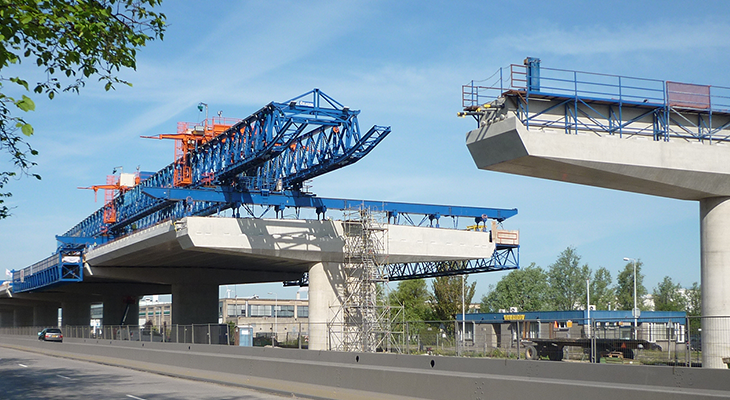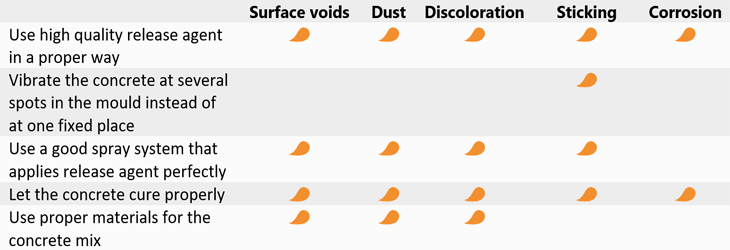
There are many factors that have influence on the quality of concrete. As a concrete release agent company we want to help you to make good quality concrete surfaces with no aesthetical issues as surface voids, deviations in your concrete due to sticking concrete, concrete stains and dusting concrete.
When the quality of the concrete surface is high, the workability is improved and the appearance is better. This is of great importance, as the competition in concrete production is high. Concrete producers need to distinguish themselves by offering more than a profitable price. This is where the aesthetic quality of concrete elements became more important.
In this article I will discuss common problems that affect the concrete surface and how these problems appear. At the end of the article you find an overview with tips to solve a specific type of problem. With Ecoratio you'll learn how to make good quality concrete!
Common problems that affect the concrete surface quality
To learn how to make good quality concrete we need to know what affects the concrete quality. As release agent company we focus on the concrete surface quality that can be affected during the releasing process. The following problems can occur during the demoulding of the concrete from moulds and formworks:
- Surface voids

Small holes that affect the concrete surface of your concrete elements can occur during the releasing process. Though the overall strength is not affected, the results of the concrete is not desirable from an aesthetical point of view.
Surface voids occur due to several factors, but has to do with the type of release agent or evaporated water. When the release agent is not used correctly or the agent is of low quality, puddles occur in the mould. This results in voids as the concrete could not fill this part of the mould. The same happens when the water to cement ratio is too high, causing puddles of water in the mould. Finally, regular air can be entrapped in the mould resulting in air bubbles that are larger than the average voids.
- Dust on moulds

Moulds can be affected by dust that concrete leaves behind when the weakness of this concrete element is high. The layer of dust occurs when the surface is porous, which can be caused by the wrong application of water and release agent. Also insufficient curing of the concrete can leave dust behind on the used moulds.
- Concrete stains

Concrete stains or discoloration on your concrete influences the appearance of your concrete surface. It does not look smooth and professional and in most cases it is not desired.
When several types of materials are used to create the concrete mix, concrete stains can occur when one batch of concrete mix is different than other batches. The slightest difference in material can already cause discoloration. Also, the overuse of water during the mixing process makes discoloration possible on the surface of your concrete. The third possible cause for concrete stains is the use of calcium chloride, that is used to speed up the curing time of the concrete. However, this leaves undesired dark concrete stains behind. And last but not least: the use of release agent. When release agents are too oily or not applied adequately, oil stains will be left behind after the demoulding process.
- Sticking concrete

Sticking occurs when concrete adheres to the mould due to insufficient application of release agent and causes damage to the concrete. The concrete becomes unusable and needs to be destroyed. Besides, sticking concrete affects the moulds and need thorough cleaning.
Causes of sticking are the use of low quality release agent, intensive vibration of the concrete at one specific point, wrong pouring of the concrete in the mould (everything is poured at one spot) and the insufficient curing process of the concrete.
- Corrosion on moulds

Corrosion on moulds can cause stains on the concrete, affecting the physical quality of the concrete. Materials that are used in the concrete mix can influence the moulds with corrosion, resulting in rust stains and expansion of the mould affecting the concrete.
How to make good quality concrete
When you desire smooth concrete surfaces it is important to understand the causes that reduce the quality of concrete surfaces. In this blog we already discussed what the issues are that decreases the quality and how this influences the quality of the concrete.
On the basis of this information we have drawn up a few actions to improve the quality of your concrete surface and which action has influence on which quality issue:

Conclusion
Each issue that can come up in the production process needs a special treatment, but it can be said that the use of a good release agent is the most important action you can take if you want to make concrete of good quality.
To solve problems with specific issues we advise you to download our Guide Concrete Quality. In this document you can read more about:
- Extensive information about quality issues;
- More information about the underlying causes for the issues;
- Specific list of solutions for each issue that affects the quality.
Or find another suitable eBook that suits your concrete problems



